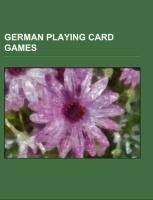
-
 Anglický jazyk
Anglický jazyk
German playing card games
Autor: Source: Wikipedia
Source: Wikipedia. Pages: 32. Chapters: Cego, Doppelkopf, Einwerfen, Elfern, Fünfzehnern, German Solo, Grobhäusern, Kontraspiel, Mariage (card game), Réunion (card game), Schafkopf, Sheepshead, Sixty-six (card game), Skat (card game), Tippen. Excerpt: Skat... Viac o knihe
Na objednávku, dodanie 2-4 týždne
14.87 €
bežná cena: 16.90 €
O knihe
Source: Wikipedia. Pages: 32. Chapters: Cego, Doppelkopf, Einwerfen, Elfern, Fünfzehnern, German Solo, Grobhäusern, Kontraspiel, Mariage (card game), Réunion (card game), Schafkopf, Sheepshead, Sixty-six (card game), Skat (card game), Tippen. Excerpt: Skat is an early 19th century 3 player trick-taking card game devised in Germany. Along with Doppelkopf it is the most popular card game in Germany and Silesia. Skat features prominently in Günter Grass's novel The Tin Drum and leads a trail connecting the plot. It is also played by many soldiers in Remarque's novel All Quiet on the Western Front, and was a favorite game of Richard Strauss, who included a hand in his opera Intermezzo. Skat was developed by the members of the Brommesche Tarok-Gesellschaft between 1810 and 1817 in Altenburg, in what is now the Federated State of Thuringia, Germany, based on the three-player game of Tarock, also known as Tarot, and the four-player game of Schafkopf (the American equivalent being Sheepshead). In the earliest known form of the game, the player in prior position was dealt twelve cards to the other players' ten each, made two discards, constituting the skat, and then announced a contract. But the main innovation of this new game was then that of the Bidding process. The first text book on the rules of Skat was published in 1848 by a secondary school Professor called J. F. L. Hempel. Nevertheless, the rules continued to differ by region until the first attempt to set them in order was made by a congress of Skat players on Saturday, 7 August 1886 in Altenburg, being the first official rules finally published in book form in 1888 by Theodor Thomas of Leipzig. The current rules, followed by both the ISPA and the German Skat Federation, date from Jan. 1, 1999. The very word Skat is a Tarok term deriving from the Italian word scarto, "scartare", which means to discard or reject, and its derivative "scatola", a box, or a place for safe-keeping. The word scarto is one still used in other Italian card games to this day, and in some German works the word is found spelled "scat". Note: Because of the many variations in the rules of Skat, the rules below are necessarily general, although rules not found in official German tournament p
- Vydavateľstvo: Books LLC, Reference Series
- Rok vydania: 2014
- Formát: Paperback
- Rozmer: 246 x 189 mm
- Jazyk: Anglický jazyk
- ISBN: 9781155623085


 Nemecký jazyk
Nemecký jazyk 








